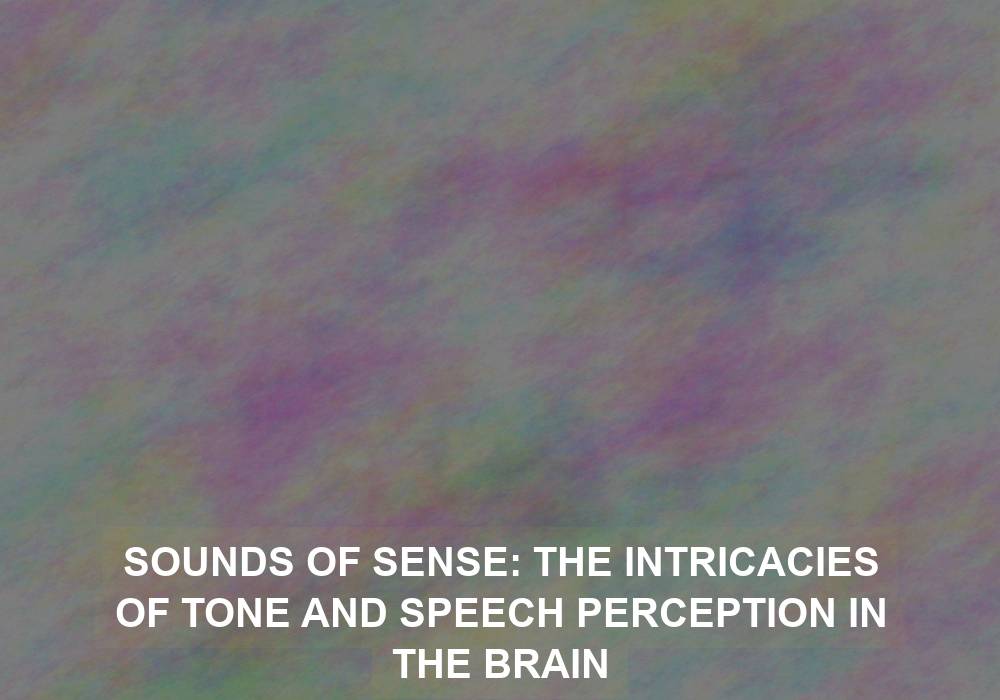Language is a remarkable phenomenon that allows humans to communicate complex ideas and emotions. One crucial aspect of language is tone, which refers to the pitch, melody, and rhythm of speech. The human brain possesses an extraordinary ability to perceive and decipher these tonal variations, enabling us to understand the subtle nuances in communication. In this article, we will delve into the intricate workings of tone and speech perception in the brain.
Understanding Tone
Tone, in the context of language, refers to the variations in pitch, melody, and rhythm that accompany speech. It adds an additional layer of meaning to our words, conveying emotions, intentions, and attitudes. For instance, a high-pitched tone might denote excitement, while a low-pitched tone may signify sadness or seriousness. Tone plays a crucial role in effective communication, as it helps to convey the intended message and evoke specific emotional responses in listeners.
The Role of the Auditory System
The process of perceiving tone begins with the auditory system, which is responsible for capturing and processing sound waves. When we speak, our vocal cords produce vibrations that travel through the air as sound waves. These sound waves are then collected by the outer ear and funneled into the ear canal towards the eardrum. The eardrum vibrates in response to these sound waves, causing three tiny bones in the middle ear (the hammer, anvil, and stirrup) to amplify and transmit the vibrations to the cochlea.
The cochlea, nestled in the inner ear, is a spiral-shaped structure filled with fluid. As the vibrations from the middle ear reach the cochlea, they cause tiny hair cells lining its walls to bend. These hair cells are responsible for converting the mechanical energy of sound waves into electrical signals that can be interpreted by the brain. The bending of hair cells stimulates the auditory nerve fibers, which then transmit the electrical signals to the brain.
The Cochlea and Neural Encoding
The cochlea’s role in tone perception is crucial. As the sound waves reach the cochlea, different frequencies of sound activate different regions of the cochlea, leading to the stimulation of specific auditory nerve fibers. This process of neural encoding involves the conversion of sound frequencies into patterns of neural activity. The patterns created by these activated nerve fibers carry tonal information to various brain regions involved in speech perception.
Mapping Tonal Information
Upon reaching the brain, the auditory nerve fibers carry the tonal information from the cochlea to various specialized brain regions involved in speech perception. One such area is the auditory cortex, which plays a crucial role in processing tonal variations. Within the auditory cortex, there are specific regions specialized for processing different aspects of tone. For example, the planum temporale, located within the auditory cortex, is involved in pitch perception. Different neurons within this region respond preferentially to specific pitch levels, allowing us to discern between high and low tones.
Researchers have also discovered that the superior temporal gyrus, another brain region, is involved in extracting tonal information from speech. This region helps us differentiate between different tones and integrate them with the lexical information to arrive at the correct meaning. The mapping of tonal information in the brain is a complex process that involves the coordination of various brain regions to decipher the intricate details of speech.
Speech Perception and Tonal Understanding
While tone itself can convey emotions and attitudes, its role in speech perception goes beyond that. Tonal variations in speech can alter the meaning of words, especially in tonal languages such as Mandarin or Thai. In these languages, differences in tone can completely change the semantic interpretation of a word. For example, the Mandarin word “ma” can mean “mother” when pronounced with a high tone, but it can mean “horse” when pronounced with a rising tone.
The brain’s ability to perceive and process these tonal variations in speech is crucial for language comprehension. It allows us to decode the intended meaning behind words and phrases. Researchers have found that specific brain regions, such as the superior temporal gyrus, are involved in extracting tonal information from speech. This region helps us differentiate between different tones and integrate them with the lexical information to arrive at the correct meaning. The brain’s remarkable ability to analyze tonal information plays a vital role in our everyday communication and understanding.
Individual Differences in Tone Perception
It is important to note that individuals may exhibit variations in tone perception. Some people may have a heightened sensitivity to tonal variations, while others may struggle to discern subtle pitch differences. These individual differences can be attributed to various factors, including genetic predispositions, linguistic exposure, and auditory processing abilities. For example, individuals who have grown up in a tonal language-speaking environment may have a more developed ability to differentiate and interpret tonal variations in speech.
Understanding these individual differences in tone perception can help us appreciate the diversity in how people perceive and interpret spoken language. It reminds us that effective communication requires not only clear articulation but also an awareness of the role of tone in conveying meaning.
Conclusion
The intricate workings of tone and speech perception in the brain highlight the remarkable capabilities of the human auditory system. Through the perception of tonal variations, our brains can extract meaning, emotions, and intentions from spoken language. This ability plays a crucial role in effective communication and understanding, bridging the gap between words and their deeper significance. So, the next time you engage in a conversation, remember to pay attention to the captivating sounds of sense that our brains unravel. By appreciating the nuances of tone, we can enhance our communication skills and foster deeper connections with others.
